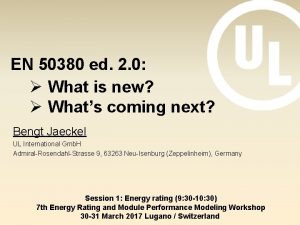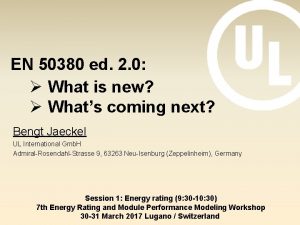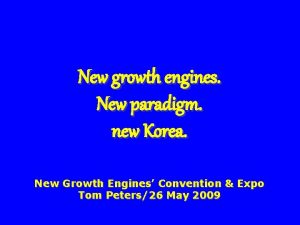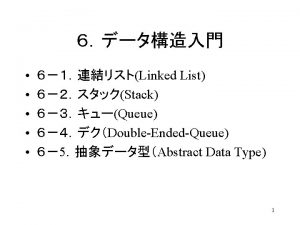EN 50380 ed 2 0 What is new















- Slides: 15

EN 50380 ed. 2. 0: Ø What is new? Ø What’s coming next? Bengt Jaeckel UL International Gmb. H Admiral-Rosendahl-Strasse 9, 63263 Neu-Isenburg (Zeppelinheim), Germany Session 1: Energy rating (9: 30 -10: 30) 7 th Energy Rating and Module Performance Modeling Workshop 30 -31 March 2017 Lugano / Switzerland

Who knows what EN 50380 is? “Old” Title: Datasheet and nameplate information for photovoltaic modules New Title: Marking and documentation requirements for Photovoltaic Modules New scope: This European Standard describes marking, including nameplate and documentation requirements for non-concentrating photovoltaic modules. This European Standard provides mandatory information that needs to be included in the product documentation or affixed to the product to ensure safe and proper use. Best practices are included in this document giving guidance on additional information, for example module’s performance at different irradiance levels. Markings, including nameplates, are permanently affixed information on the PV modules, which indelibly states the rating and other information as required by the relevant standard for safe use and maintenance. While, documentation information is a technical description separate from the photovoltaic module. This European Standard is based on IEC and EN standards defining marking, nameplate and documentation requirements for PV modules. page 2

Overview • • • History / Overview Current status of EN 50380 project Some details Discussion points Outlook for EN 50380 Summary page 3

History EN 50380 1994 - early days! Feb 2014 Project for Development of DIN 40025 maintenance initiated „Datenblatt- und Typschildangaben für Photovoltaik-Module“ May 1997 Publication of DIN 40025 Feb 2016 1 st draft circulated with clear separation of mandatory requirements and best practices Project started for EN 50380 (TC 82 did not exist then) 2012 -2014 Final discussions during anual CENELEC Meeting Several Meeting on GER NC level Kick-off Meeting for EN 50380 to “add Energy Rating” 2003 Publication of EN 50380 ed. 1 Publication as EN 50380 edition 2 Feb 2017 Jan 2012 Feb 1998 Q 3 2017 Nov 2016 Feb 2015 Change of Project leader Preperation of final draft for Vote, including NC comments July 2014 April 2016 Project officially started: PR=25384 Voting process July 2016 Comments received from NCs page 4

Current status of EN 50380 Comments received in July 2016: 116 Comments by type: – General: 14 – Editorial: 64 – Technical: 38 ED: We must write for example: “… devices with a 1 h, 1, 35 IR overload rating, …” Instead of: “… devices with a 1 hr, 1. 35 IR overload rating, …” (ISO/IEC directives, Part 2, 2016) ED: Change request from V to U VOC UOC VMPP UMPP Comments received from: - Austria Germany Finland UK Netherlands Portugal Photovoltaic cell Final: Proposal: Original: TE Comment: Proposal Answer: The main consequence of in-roof mounting with low radiant and convective cooling on the back side of the module is (much) higher temperature when compared to open rack mount in the same climate zone. But how to specify in the data sheet? Maximum use temperature sufficient to prevent too hot running modules? Noted - No proposal given to address issue and as of today no reference standard exist. IEC TC 82 WG 2 started discussions on that topic page 5

Next project steps of EN 50380 • Nov 2016: Comments worked into the draft • Nov 2016 – March 2017: CENELEC CO work on document • April 2017: CCMC starts the Vote (2 months period) • June 2017: Finalization of document (2 months) • Aug 2017: Publication page 6

New document structure Split content in: è Mandatory information è Best Practice information From scope of EN 50380: This European Standard provides mandatory information that needs to be included in the product documentation or affixed to the product to ensure safe and proper use. Best practices are included in this document giving guidance on additional information, for example module’s performance at different irradiance levels. page 7

Mandatory & Best practice What is mandatory information? Everything that is needed to install, operate and maintain the PV modules safely. What is best practice information? Actually the answer is also very simple: Everything that is NOT needed to install, operate and maintain the PV modules safely. That basically means all performance related information like low light behaviour, type of cell or even the dimensions of the PV module. As this information are quite important to perform project planning and yield forecasting they are NOT relevant to install a safe PV system Why splitting? page 8

Motivation for splitting Nameplate/Marking requirements IEC 61215 -1 FDIS (July 2015) IEC 61730 -1 CDV (status July 2015) EN 50380 draft (status June 2015) IEC 61853 -1 : 2011 Each module shall include the following clear and indelible markings: Each PV module shall include the following clear and indelible markings: a) name, registered trade name or registered trade mark of manufacturer; a) name, registered trade name, or registered trade mark of manufacturer; Name, registered trade name or registered trade mark of manufacturer; b) type or model number designation; Type or model number designation; c) serial number (unless marked on other part of product); c) serial number; Serial number; The serial number identification must be placed in such a way that it is non-removable (preferable by encapsulation) and readable Serial number; after installation. NOTE: It is allowed that this serial number identification is covered after installation by a frame e. g. in façade installations. d) date and place of manufacture; alternatively serial number allowing to trace the date and place of manufacture; d) date and place of manufacture; alternatively serial number assuring traceability of date and place of manufacture; alternatively serial number allowing to trace the date and place of manufacture Name, monogram or symbol of the manufacturer; Type or model number; The date and place of manufacture shall be marked on the module or be traceable from the serial number. è Several standards have different requirements – not always aligned è Some are mandatory safety standards, some are helpful information sources EN 50380 summarized and groups all given requirements/information See outlook page 9

Highlighting some requirements Example: Mandatory The documentation shall contain the following electrical information: Saf a) polarity of terminals or leads; ety rel b) “Maximum system voltage” or Vsys; eva c) Maximum overcurrent protection (OCP) rating nt i nfo d) Class of protection against electrical shock rma e) “Voltage at open-circuit” or “Voc” including rated production tolerance tion f) “Voltages at maximum power point” or “Vmax” g) “Current at maximum power point”; or “Imax” h) “PV module maximum power” or “Pmax ” i) “Current at short-circuit”; or “Isc” j) Relative temperature coefficients in [%/K] for Isc, Pmax and Voc at STC Yie ld r Example: Best practice ele van a) Nominal module operating temperature – NMOT (MQT 05) t in b) Performance at NMOT (MQT 06. 2). form c) Performance at low irradiance (MQT 07). a tion page 10

Discussion points • What are Mandatory and Best practice requirements? – At some points some best practice information will be mandatory – dependent on country • Some terms and their verification – What is “permanently affixed”, “permanent marking”, “indelibly” and “durable construction” ? – How to verify that? Proposal: “The durability of markings (the permanently affixed information on the PV modules with all indelibly states ratings) is verified with Visual inspection MST 01 and Durability of markings Test MST 05 after passing all tests from Sequence A to F. “ page 11

Outlook for EN 50380 IEC 61730 series (Mandatory) IEC 61215 series (Best practice) Part 1 – General requirements EN 50380 (More mandatory) Part 1 – Construction requirements Marking and documentation X X 5. Marking and documentation 5. 1. Name plate 5. 2. Marking and documentation 5. 2. Documentation 5. 2. 2. Marking 5. 2. 3. Documentation Part 1 -1 c-Si Part 1 -2 Cd. Te b Part 2 – Test procedures e n i Part 1 -3 a-Si & µ-Si om C Part 1 -4 CIS&CIGS Part 2 – Test procedures page 12

Outlook for EN 50380 Part 1 – General requirements from IEC 61730 and IEC 61215 Part 2 - Marking and documentation EN 50380 – summary from all marking and documentation requirements Part 3 – Construction requirements from IEC 61730 Part 1 -1 c-Si Part 1 -2 Cd. Te Special requirements for each technology Part 1 -3 a-Si & µ-Si Part 1 -4 CIS&CIGS Part 4 – Test procedures Testing procedures summarized from all used standards page 13

Summary • Short history EN 50380 • EN 50380 project status • Comments and new structure with – Mandatory & – Best practice information • Some discussion points • Outlook what could happen with EN 50380 page 14

Thank you for your attention
 Din en 50380
Din en 50380 Njbta
Njbta Speech
Speech New classical and new keynesian macroeconomics
New classical and new keynesian macroeconomics Both new hampshire and new york desire more territory
Both new hampshire and new york desire more territory New classical and new keynesian macroeconomics
New classical and new keynesian macroeconomics New york pennsylvania new jersey delaware
New york pennsylvania new jersey delaware Venn diagram roosevelt taft wilson
Venn diagram roosevelt taft wilson New-old approach to creating new ventures
New-old approach to creating new ventures Chapter 16 toward a new heaven and a new earth
Chapter 16 toward a new heaven and a new earth Fresh oil new wine
Fresh oil new wine New consumer capabilities in marketing
New consumer capabilities in marketing Neil thisse is a loyalist answers
Neil thisse is a loyalist answers Marquee cinema new hartford new york
Marquee cinema new hartford new york American new wave film
American new wave film Ever ancient ever new
Ever ancient ever new





























